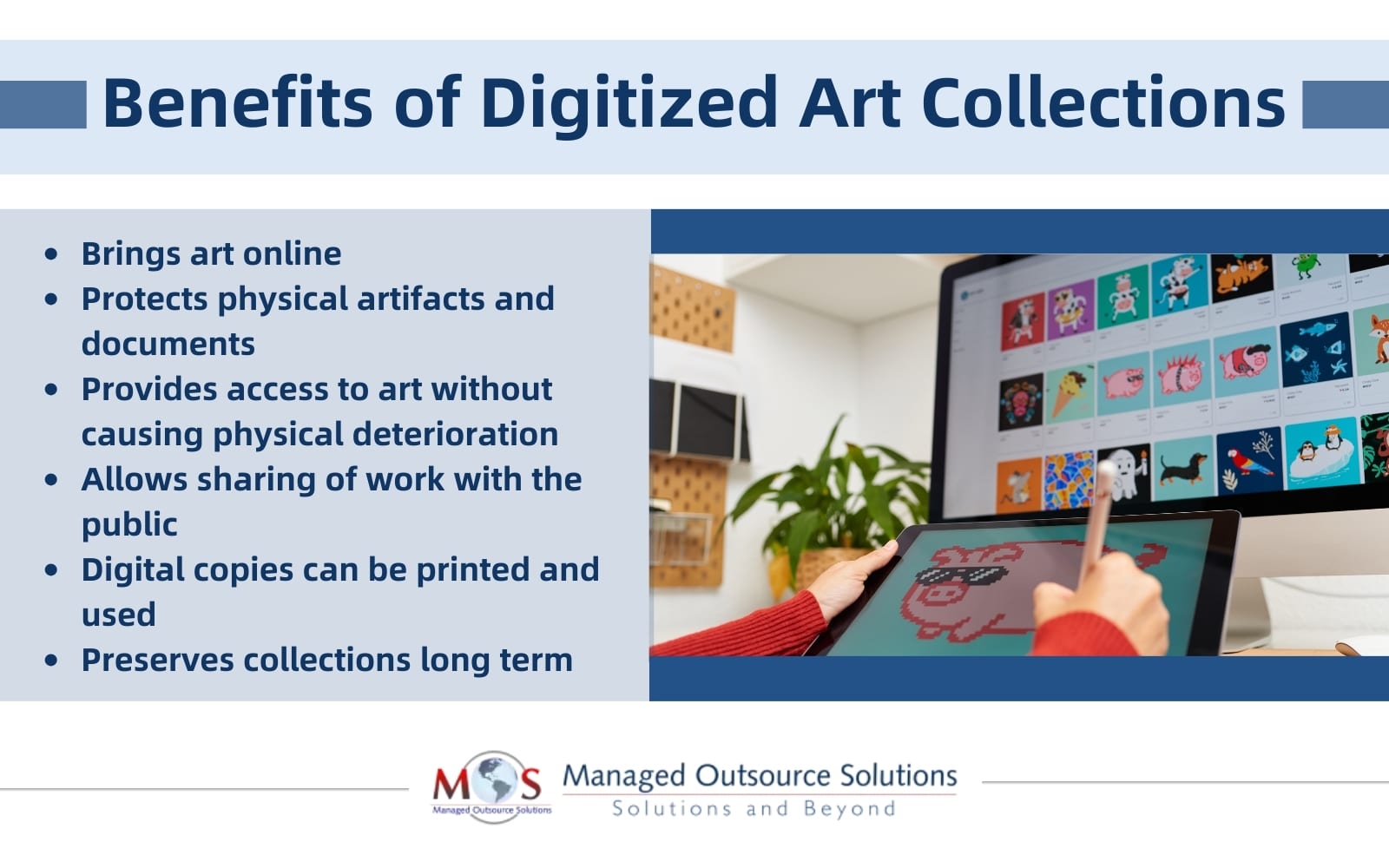The popularity of a piece of artwork depends on how easily it can be disseminated to increase its reach. The advent of digitization has had a profound impact on making artwork more likely to get noticed as well as on the way art is marketed, consumed and valuated. Literally millions of works of art including paintings, prints, drawings, photographs, sculpture and the like, hosted by museums, galleries, and research institutions are being scanned and converted to digital images with the assistance of data conversion services. This makes the art work available online for commercial or educational purposes or simply, amateur viewing.
The Google Art Project is an excellent example for an online platform that allow public access to high-resolution images of artworks. Artworks housed in 17 international museums are scanned and digitally converted to make it available for users, allowing them to explore physical and contextual information about artworks and compile their own virtual collection. The system provides a virtual tour to famous museums such as The Metropolitan Museum of Art and MoMA in New York, The State Hermitage Museum in St. Petersburg, Tate Britain & The National Gallery in London, and more.
In October 2023, Radio IQ reported on a Radford University student project involving the digitization and cataloguing of over two thousand works of art from the in the Radford University Art Museum’s permanent collection for a new online database. This collection consists of pieces by Andy Warhol, Pablo Picasso, and Dorothy Gillespie as well as items created over the years by Radford students. The collections are now available at https://ruartmuseum.catalogaccess.com/home.
Benefits of Digitizing Art Work
- Conservation and Accessibility: The preservation of art is one of the biggest benefits of digitizing it. Over time, traditional artworks can be damaged as result of handling, environmental causes, or accidents. Digitization of their works allows artists and collectors to build a lasting digital archive that maintains the integrity of the original artwork. Also, digitization improves accessibility by removing geographical restrictions. Digital art allows art enthusiasts to view and enjoy works of art from all over the world, giving artists more visibility and acclaim. Digitization also helps museums and galleries by allowing them to exhibit their collections online, which expands their audience and promotes cross-cultural interaction.
- Flexibility and Collaboration: Digital formats are incredibly versatile. With digital art, artists can readily edit their creations, try out new styles and approaches, and make changes without sacrificing the integrity of the original work. This adaptability gives artists the freedom to push boundaries and discover uncharted territory, creating countless creative opportunities. Another area where digitizing art work excels is collaboration. Artists no longer need to be physically present to collaborate remotely, exchange digital data with ease, or work on projects together. This cooperative attitude promotes knowledge exchange and the growth of skills while cultivating a thriving artistic community.
- Revenue Generation and Market Growth: For artists who want to make money off of their works, digitizing their artwork can be a strategic choice. Artists can sell digital artworks, attract a worldwide audience, and experiment with new revenue streams through digital art platforms, online markets, and NFT (Non-Fungible Token) marketplaces. The dynamic and ever-changing digital art market provides artists with a platform to exhibit their work and establish connections with a wide range of art aficionados and collectors. Digitization provides collectors with an easy way to organize and present their art collections. Collectors can curate and experience their collections digitally through the use of digital catalogs, virtual galleries, and augmented reality (AR) applications, which improves both the overall viewing experience and investment value.
- Sustainability and its Effect on the Environment: Digitizing art is in line with the art world’s efforts towards sustainability. Artists contribute to a more sustainable and environmentally friendly art ecosystem by using digital platforms and minimizing the use of physical materials. Consuming digital art also reduces the carbon impact of producing, shipping, and storing conventional art. Furthermore, by presenting a diverse array of artistic expressions, genres, and cultural influences, digital platforms foster inclusivity and diversity. This diversity honors the distinctive viewpoints of artists from around the world and enhances the landscape of art. It also encourages conversation.
Digitization of art collections has enabled audiences to gain access to magnificent artworks and to experience them without the restrictions of geographical barriers. However, to produce perfect quality images, it is necessary to use scanners equipped with advanced features.
Selecting a Suitable Document Scanner
The scanner should be large enough to handle the piece without reducing the image quality or damaging the original. Scanners with special features are preferred, as regular scanners generally aren’t capable of handling/scanning poster board, watercolor and acrylic paintings.
A majority of large images are scanned at 200, 300 or 400 dpi to reduce the total size of the image file. Though finding the best scanner for each type of art is difficult, it is preferable to select something that offers at least 600dpi optical resolution.
The scanner should provide a higher definition image with excellent color rendition. The digital revolution has already transformed visitors’ experience in museums, and it has also transformed art historians’ experience for the better. Art galleries have come to realize the many advantages of having an online presence especially for marketing purposes. Digitization allows the creation of databases with detailed information about prices, the type and characteristics of a work of art, authorship, origin and records of previous sales.
Ready to digitize your art collection?
Leverage our document scanning services and improve your reach and impact.
Are you planning to digitize your art work?
Read our blog post on the
Important Dos and Don’ts Of Digitizing Artwork
By preserving art for future generations, fostering collaboration and innovation, tapping into global markets, and contributing to a greener planet, digitizing artwork is a transformative journey that enriches the entire art community. As we navigate the digital frontier, let’s embrace the power of digitization with the help of reliable data conversion services to unlock new possibilities and elevate the art world to greater heights of inspiration and impact.





